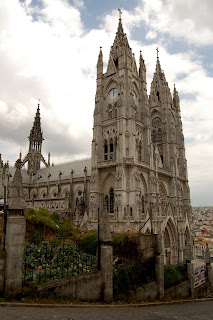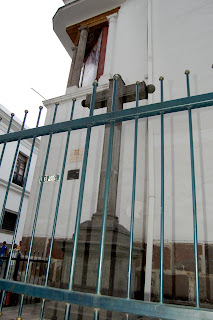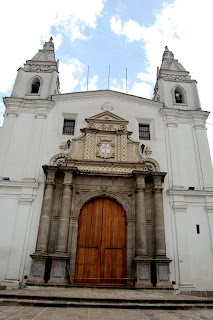Walking Down the Calle de las Siete Cruces
I climbed to start a little higher up the hill at the Basilica, and took my time watching children walking home or getting out of their school buses, parents rushing them along, two young nuns at the church at Santa Barbara directing two workers in their efforts to put up a sign announcing an indepth prayer weekend. They wore rough brown gowns, perhaps they were Santa Clara nuns, since the banner described a 'San Fransisco de Asis' focus. The seventh cross stood in front of the church of Santa Barbara, the patroness of the struggles against the barbarians and infidels. The church originally served only Spaniards and Criollos (first generation Spaniards born in Hispanic America). It was closed, as are most of the churches most of the day in Quito. I followed Garcia Moreno Street to the Church and Monastery of the Concepcion, and the sixth cross. I passed the Government Palace, the Archbishop's Palace and Independence Square, and found the fifth cross in front of he Cathedral, and the fourth one nearby in front of the Sagrario Church, and the third cross in front of La Compañia. I was distracted at the Centro Metropolitano exhibit of Goya's etchings, which was to close in two days. It was composed of both his etchings and attempts by local artisits to match his vision. Both sets of lithographs were compelling.I did not enter each church; some were closed, some I had seen several time before. My purpose in the journey today was to familiarize myself with the route so that I could bring Debra or Rebecca and explain what they will see. The second cross was in front of the Monastery and Church of Carmen Alto, which was built on the site of Mariana de Jesus' house. Mariana de Jesus was the first saint of Quito, a very religious woman who did not have a religious affiliation but felt close to the Jesuits, and wanted to donate her house to the Carmelites, for whom it became a convent. There is a statue of Mariana de Jesus to the right of the church doors. Right in front of the Monastery is the 'Queen's Arch', built to accommodate a public altar. The first cross is much further away, across 24 de Mayo, in front of the Saint Lazarus Psychiatric Hospital. I felt too uncertain to walk where I was unfamiliar ( the base of the Panecillo has a dangerous reputation), so I turned down to La Ronda, which looks so very different in the daytime, without vendors selling canelazo and music blasting from each bar, restaurant and coffee shop. I turned back to Plaza Grande, where I suddenly realized I needed to get home and pick up Maya's ballet clothes and violin and get her to where she needed to go. I will be back in the Centro Historico with the alumni tour from Hopkins tomorrow. I wonder what the tour will be like, what the guides choose to show the tourists. I believe I am almost ready to give the tour!







 La Concepcion Cross
La Concepcion Cross
 Cross and Cathedral
Cross and Cathedral El Sagrario and Cross
El Sagrario and Cross Colonial Beauties
Colonial Beauties


 Carmen Alto
Carmen Alto Queen's Arch
Queen's Arch

 La Ronda Deserted
La Ronda Deserted
No comments:
Post a Comment